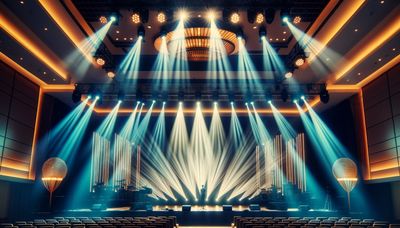Signed in as:
filler@godaddy.com
Signed in as:
filler@godaddy.com
Professional audiovisual components in a Cinema play a critical role in delivering high-quality visual and audio experiences for moviegoers. Here are the key components you'll find in a professional cinema audiovisual system:
These components come together to create a complete and immersive audiovisual experience for moviegoers in a professional cinema. It's essential to regularly maintain and update these components to meet industry standards and deliver the highest quality cinematic experience.

The market for professional stage lighting in the audiovisual (AV) industry represents a dynamic and evolving segment, reflecting the growing demand for advanced technological solutions in various performance and presentation spaces.
The professional stage lighting market is expected to continue growing, driven by technological innovations and expanding applications. The increasing emphasis on immersive experiences in various events and performances will further propel the market forward.
The professional stage lighting market in the AV industry is marked by continuous innovation and expansion. As technology evolves and applications diversify, the market is poised for further growth, offering enhanced experiences to audiences and new opportunities for businesses and venues.
This page provides an overview of the market dynamics of professional stage lighting in the AV industry, highlighting current trends, market drivers, challenges, and the future outlook.

Architectural Lighting plays a crucial role in enhancing the aesthetics and functionality of architectural spaces, such as buildings, landscapes, and public areas. The components and feature requirements for a comprehensive architectural lighting system are as follows:
Architectural lighting should be designed to enhance the visual appeal of architectural elements, create a safe and inviting environment, and provide energy efficiency. Collaboration with lighting designers and architects is essential to ensure that the lighting design complements the architectural vision and meets the specific needs of the project.

Audiovisual systems play a vital role in Corporate settings, facilitating effective communication, collaboration, and presentations. Here are the key audiovisual system requirements for a corporate environment:
The specific audiovisual system requirements in a corporate environment may vary based on the organization's size, industry, and specific needs. Collaborating with professional audiovisual consultants and technicians can help tailor the system to meet the unique requirements of the corporate setting.

Audiovisual systems in an educational environment are essential for facilitating effective teaching and learning. The requirements for such systems can vary depending on the type of educational institution, the level of education, and specific needs, but here are key components and features often needed:
The specific audiovisual system requirements in an educational environment can vary based on the educational institution's level, size, and specific goals. Collaboration with professional audiovisual consultants and technicians is essential to design and implement systems that meet the unique needs of the educational setting.

Audiovisual systems in Brand Stores play a crucial role in creating an immersive and engaging shopping experience, reinforcing brand identity, and promoting products or services. The specific requirements for an audiovisual system in a brand store may vary depending on the brand's image, target audience, and budget, but the following components and features are generally important:
The specific requirements for an audiovisual system in a brand store should align with the brand's image, target audience, and marketing strategy. Collaborating with professional audiovisual consultants and technicians is advisable to ensure that the system meets the brand's specific needs and enhances the overall shopping experience.

Audiovisual systems in Dance Clubs are crucial for creating an immersive and enjoyable experience for patrons. These systems should be capable of delivering high-quality sound and visuals that complement the music and atmosphere. Here are the key audiovisual system requirements for a dance club:
Designing and maintaining a high-quality audiovisual system is essential for the success of a dance club, as it contributes to the overall experience and sets the mood for the venue. Collaborating with professional audiovisual consultants and technicians is advisable to ensure that the system meets the specific needs of the club and its patrons.

Audiovisual systems in a restaurant can enhance the dining experience, set the ambiance, and even provide entertainment. The specific requirements can vary depending on the type of restaurant (e.g., fine dining, casual, sports bar, or themed restaurant) and its overall concept. Here are some common audiovisual system requirements for a restaurant:
The specific audiovisual system requirements in a restaurant should align with the restaurant's concept, clientele, and goals. Professional audiovisual consultants and technicians can help design and implement systems tailored to meet the restaurant's unique needs and enhance the overall dining experience.

Audiovisual systems in a Coffee Shop can help create a welcoming and cozy atmosphere, provide entertainment, and improve the overall customer experience. Here are the key audiovisual system requirements for a coffee shop:
The specific audiovisual system requirements for a coffee shop should align with the coffee shop's concept, target audience, and goals. Collaborating with audiovisual professionals can help design and implement a system that enhances the coffee shop's unique atmosphere and customer experience.

Creating a comprehensive home automation system involves integrating a wide range of audiovisual components and technologies to enhance convenience, entertainment, and overall functionality in your home. Here are the key audiovisual system requirements for a home automation setup:
The specific requirements for a home automation audiovisual system can be customized to match your unique preferences and needs. Working with professional home automation experts can help you design and implement a system that enhances your home's convenience, entertainment, and efficiency.

Creating a high-quality home theater experience involves carefully selecting and integrating audiovisual components to deliver immersive entertainment. Here are the key audiovisual system requirements for a home theater:
The specific requirements for a home theater can be customized based on your budget, room size, and personal preferences. Working with professional home theater installers and designers can help you create a theater that meets your specific needs and delivers a truly immersive entertainment experience.

We use cookies to analyze website traffic and optimize your website experience. By accepting our use of cookies, your data will be aggregated with all other user data.